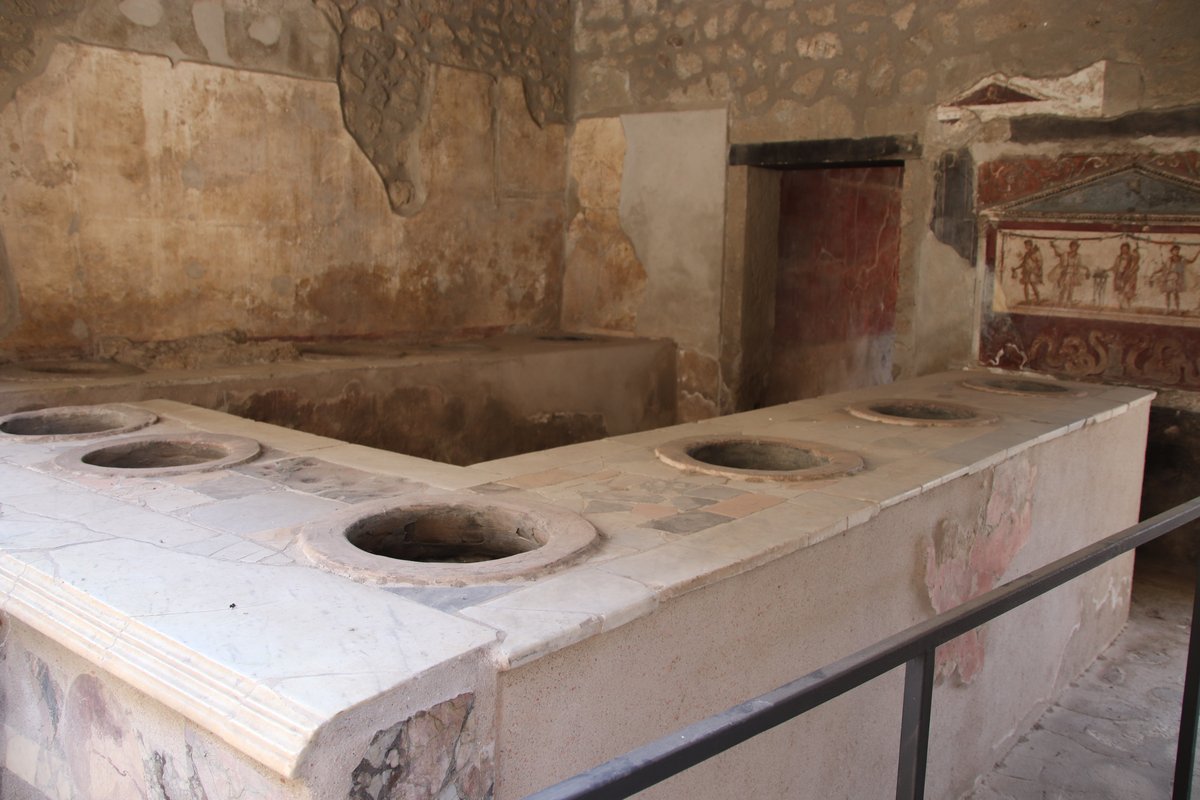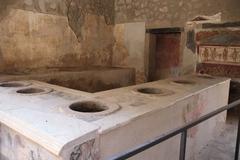
Visiting the Caupona of Lucius Betutius Placidus in Pompeii, Italy: Tickets, Hours, and Tips
Date: 14/06/2025
Introduction
Pompeii, a UNESCO World Heritage Site near Naples, Italy, offers an extraordinary window into daily life in ancient Rome. Among its many preserved ruins, the Caupona of Lucius Betutius Placidus (often referenced as Lucius Vetutius or Betutius Placidus) stands out as one of the best-preserved examples of a Roman thermopolium—an ancient “fast food” counter and tavern. Located on the lively Via dell’Abbondanza, this establishment combines commercial, social, and religious aspects of Roman culture, attracting both scholars and tourists eager to experience the rhythms of a vanished world.
This comprehensive guide covers the historical context, archaeological discoveries, architectural highlights, practical visitor information (including hours and ticketing), current preservation efforts, and essential travel tips to help you make the most of your Pompeii visit.
Table of Contents
- Introduction
- Historical Context: The Role of Thermopolia and Cauponae in Pompeii
- Archaeological Discoveries and Artifacts
- Architectural Features of the Caupona
- Visitor Information: Hours, Tickets, and Access
- Travel Tips and Nearby Attractions
- Preservation and Responsible Tourism
- Frequently Asked Questions (FAQ)
- Conclusion
- Sources
Historical Context: The Role of Thermopolia and Cauponae in Pompeii
Social and Urban Significance
Thermopolia (hot-food counters) and cauponae (taverns) were integral to Roman urban life, especially in bustling cities like Pompeii. By 79 AD, over 80 thermopolia served a population of approximately 12,000–15,000 residents. Many homes, particularly those of the lower and middle classes, lacked kitchens, making these establishments essential for daily meals (pompeiiarchaeologicalpark.com; planetpompeii.com).
The Caupona of Lucius Betutius Placidus exemplifies strategic placement, sitting prominently at the intersection of Via dell’Abbondanza and Vicolo dei Balconi in Regio V, maximizing foot traffic and visibility (pompeiiarchaeologicalpark.com).
Social Function
Beyond offering food and drink, thermopolia and cauponae were vibrant social hubs. People from various social backgrounds gathered here to eat, drink, and discuss news. Many such businesses were operated by freedmen, reflecting opportunities for upward mobility in Roman society (pompeiiarchaeologicalpark.com). The discovery of a large coin hoard at the Caupona underscores its commercial success and the dynamic economy of ancient Pompeii (seepompeii.com).
Religious rituals were also embedded in daily operations, as evidenced by the presence of a lararium (shrine) dedicated to household and trade gods such as Mercury and Dionysus.
Culinary Offerings
Typical fare included bread, olives, cheeses, lentils, stews, fish, and wine, often flavored or diluted as per Roman custom (pompeiiarchaeologicalpark.com). The diversity of food remains and imported amphorae demonstrates Pompeii’s connections to wider Mediterranean trade networks.
Regulation and Reputation
While these venues were vital for the populace, they sometimes attracted criticism from Roman elites due to their association with rowdy behavior. Nevertheless, their prevalence throughout the city highlights their essential role in everyday life (historyandmystery.org).
Archaeological Discoveries and Artifacts
Discovery and Excavation
The Caupona was uncovered during systematic excavations of Pompeii, which began in the 18th century. Located on Via dell’Abbondanza, it was identified by a painted sign bearing the owner’s name (Pleiades). Archaeological efforts over the years have provided a detailed picture of its operation and significance (Nomad Epicureans; Along Dusty Roads).
Structure and Layout
The main feature of the Caupona is its marble-topped thermopolium counter, embedded with large terracotta dolia (storage jars) for serving hot food and drinks. Behind the counter, rooms served as both public dining spaces and private family quarters, including an oecus (dining room) and triclinium (formal dining area) (madainproject.com; italyguides.it).
Significant Finds
- Food Remains: Excavations revealed traces of pig, goat, fish, duck, snails, and fava beans, providing direct evidence of the menu. Fava beans may have been used to flavor wine, per Roman culinary practice (madainproject.com).
- Coin Hoard: One of the most remarkable discoveries was a cache of 1,385 bronze coins (worth roughly 585 sesterces), likely several days’ takings, found hidden in a dolium (archeology.dalatcamping.net; pompei.it).
- Lararium Fresco: A painted shrine depicts the household’s Genius (spirit), Lares (protective gods), Mercury, and Dionysus, highlighting the interplay of commerce, family, and religion (madainproject.com; italyguides.it).
- Frescoes and Decorations: Fourth Style frescoes with mythological themes, food still lifes, and painted panels adorn the walls and counter (madainproject.com).
- Human Remains: Remains discovered within the Caupona may belong to the proprietor and possibly a thief, providing poignant evidence of the abrupt disaster (madainproject.com).
Architectural Features of the Caupona
- Facade and Entrance: The main entrance faces Via dell’Abbondanza and is adorned with painted advertisements and graffiti.
- Thermopolium Counter: Marble-topped, with built-in dolia for storing and serving food and drink.
- Dining and Social Spaces: Several small rooms and alcoves for patrons, with evidence of benches and tables for in-house dining.
- Private Quarters: Living spaces for the owner and family, including a kitchen, storerooms, and a domestic shrine.
- Decorative Elements: Brightly colored frescoes, simple black-and-white mosaics, and graffiti provide insight into both daily activities and the personalities of Pompeii’s residents.
- Water and Hearth: Lead piping supplied water, while ovens and hearths were used for food preparation.
- Storage: Amphorae and jars stored wine, oil, and other staples.
Visitor Information: Hours, Tickets, and Access
Opening Hours
The Caupona is open during the main hours of the Pompeii Archaeological Park:
- April to October: 09:00–19:00 (last entry at 17:30)
- November to March: 09:00–17:00 (last entry at 15:30)
Seasonal and holiday schedules may apply; always check the official website before your visit.
Ticket Prices
- Standard adult ticket: €16–€19
- EU citizens (18–25): €2
- Children under 18: Free (with ID)
- First Sunday of each month: Free entry, but expect heavy crowds
Tickets can be purchased online or at the entrance. Advance booking is strongly recommended due to daily visitor caps and high demand, especially during peak periods (Untold Italy).
Accessibility
- Pompeii is partially accessible, with designated routes for wheelchairs, though uneven surfaces and steps around the Caupona can be challenging.
- Visitors with mobility needs should consult the Pompeii accessibility guide or contact staff for assistance.
Travel Tips and Nearby Attractions
- Footwear: Wear comfortable shoes for navigating cobblestones and ancient streets.
- Essentials: Bring water, sunscreen, and a hat, particularly during summer.
- Site Map: Download or collect a map at the entrance due to the site’s vastness.
- Best Times: Early morning or late afternoon visits help avoid crowds and midday heat.
- Nearby Attractions: The Forum, Amphitheatre, Villa of the Mysteries, and House of the Faun are nearby highlights.
- Photography: Allowed for personal use (no flash or tripods inside buildings).
Guided tours and audio guides are available for rent or booking through authorized providers such as GetYourGuide and Viator.
Preservation and Responsible Tourism
Conservation Challenges
The Caupona and other Pompeii sites face challenges from:
- Weathering (rain, wind, sunlight)
- Seismic activity
- Heavy tourist footfall (Pompeii Archaeological Park)
Strategies for Preservation
- Structural stabilization using non-invasive, reversible techniques.
- Protection of frescoes with microclimate monitoring, selective coverings, and protective coatings.
- Visitor management through timed entry, visitor caps, physical barriers, and guided tours.
- Technological solutions such as 3D scanning, LiDAR, and environmental sensors to monitor site health.
- Community and international collaboration for funding, research, and education (The Travel).
Visitor Role
- Do not touch frescoes or structures, and stay on marked paths.
- Dispose of litter responsibly and respect all posted guidelines.
- Support official tours and preservation initiatives.
Frequently Asked Questions (FAQ)
Q: What are the opening hours for the Caupona and Pompeii Archaeological Park?
A: April–October: 09:00–19:00; November–March: 09:00–17:00. Last entry is typically 1.5 hours before closing.
Q: How can I buy tickets?
A: Via the official online portal or at park entrances. Advance booking is recommended.
Q: Is the Caupona accessible for people with disabilities?
A: Some areas are accessible, but uneven ancient paving and steps may limit access around the Caupona.
Q: Are guided tours available?
A: Yes, with options through GetYourGuide, Viator, and at the main entrance.
Q: Can I take photos inside the Caupona?
A: Yes, for personal use. Flash and tripods are not allowed inside.
Conclusion
The Caupona of Lucius Betutius Placidus serves as a vivid testament to Pompeii’s social, culinary, and economic vibrancy on the eve of disaster. Its well-preserved counter, frescoes, and artifacts offer a unique opportunity to step into the everyday world of ancient Romans. Thanks to ongoing conservation and management, visitors can experience this remarkable site while contributing to its preservation for future generations.
For up-to-date travel tips, virtual tours, and further reading, consult the official Pompeii website and trusted guides. Enhance your visit with the Audiala app for expert audio tours and real-time information.
Sources
- This is a sample text. (pompeiisites.org)
- This is a sample text. (pompeiiarchaeologicalpark.com)
- This is a sample text. (pompeiiarchaeologicalpark.com)
- This is a sample text. (planetpompeii.com)
- This is a sample text. (nomadepicureans.com)
- This is a sample text. (alongdustyroads.com)
- This is a sample text. (madainproject.com)
- This is a sample text. (ticketone.it)
- This is a sample text. (untolditaly.com)
- This is a sample text. (untolditaly.com)
- This is a sample text. (pompeiiarchaeologicalpark.com)
- This is a sample text. (thetravel.com)































































